How to Make Long-Fermented Sauerkraut
We love making this easy and classic homemade sauerkraut. I recommend a long-fermented sauerkraut for a mellower taste and increased probiotics.
These days, everyone talks about gut health, probiotics, and ferments. For good reason! Not only are fermented foods delicious but often make food easier to digest to begin with or aiding the digestive process with enzymes and probiotics. For a long time, I have been including fermented foods into our diet. Homemade yogurt is a great start. Or sourdough bread. Or sauerkraut …
What equipment to use
Considering that people have been making sauerkraut for millennia, you really don’t need any special equipment. However, to make preparation smooth and easier, I recommend the following items:
- a very good, sharp knife (these are my favorite ones)
- or a mandolin slicer (I like this one)
- a non-reactive bowl (I love my enamel bowl but you could use glass, wood, or ceramic)
- a kitchen scale (such as this one)
- mason jars or a sauerkraut crock
- wooden tamper (like this one)
My favorite quick sauerkraut hack
Most of the time, I love using fresh crisp heads of cabbage. But there are days when I am a bit short on time and still would like to make long-fermented sauerkraut. So here’s my quick little sauerkraut hack: if you have a Trader Joe’s near you, you can get shredded green cabbage or a shredded green and red cabbage mix with carrots. I know that they come in a plastic bag and are not as fresh as buying a whole head. But again, sometimes not having to shred the cabbage can make the difference between making sauerkraut and not making sauerkraut.
Quick overview of how to make sauerkraut
There isn’t a whole lot to making sauerkraut. Essentially, you shred the cabbage, add salt, press everything into your mason jars or crock, place a cabbage leave and one or more fermentation weights on top to keep everything submerged, and put the fermentation lid on top. That’s all. It’s very simple but there are a few things I would like to talk about.
How much salt to add
Ideally, you want a 2% salinity. In other words, you weigh your cabbage and calculate 2% of that. That is how much salt to add to it.
If for any reason, you can’t weigh your cabbage or you don’t have a scale, you can still get things right. Add some salt to your cabbage, mix everything up, and taste it. If it tastes saltier than you would for eating but not so salty that you want to spit it out, then you have the right salinity.
How to adjust the texture and taste of your sauerkraut
Now, if you’re using slightly less salt than 2% , you will get softer sauerkraut. If you are using a bit more than 2% you will get crunchier sauerkraut.
Also, shredding the cabbage very fine will give you softer kraut. Using a coarser cut will make your sauerkraut a bit more crunchy.
If you don’t care much for the sourness of sauerkraut you can do a few things:
- adding an apple to the cabbage mellows the sauerkraut
- or adding a red beet to red cabbage adds a bit more sweetness
- using a longer fermentation
What is long-fermented sauerkraut?
Once you press the salted cabbage into the mason jars or crock and put the lid on, the sauerkraut will go through various stages.
After about 3-6 days, you will have freshly fermented sauerkraut. It will have a fine taste and will contain some probiotics.
However, I love to long-ferment my sauerkraut for 30 days. After that time, your sauerkraut will not only have a mellower, less acidic, and more complex taste but also a maximum of gut-friendly bacteria. In the olden days, people would even leave their sauerkrauts to ferment for up to 6 months.
Why I let my salted cabbage sit for one hour
Before, I told you to add the salt to your cabbage and mix things up. There is nothing wrong with moving ahead with the recipe and pressing the cabbage into the mason jars.
In order to make things easier, I let the salted cabbage sit for about one hour. During this time, the salt will draw the juices out of the cabbage. You will notice that your cabbage will look wet and glossy. This will also make the cabbage a bit softer thus making it easier to press it into the jars or crock.
How to make sauerkraut
If I am using the pre-shredded cabbage, I simply dump that into my bowl.
However, if I am using a whole head of cabbage, I like to cut it in halves and then quarters. Using my mandolin slicer, I cut the cabbage into thin strips right into my bowl. Alternatively, you can use a knife and cut then cabbage as thin or thick as you like.
And here’s another little hack: I have weighed my enamel bowl and written the weight on its bottom. When I add the cabbage (and potential other ingredients), I can place the bowl on the scale and simply subtract its weight from the total. That number is the weight of my vegetables. And now I can easily calculate 2% of that to find out how much salt to add.
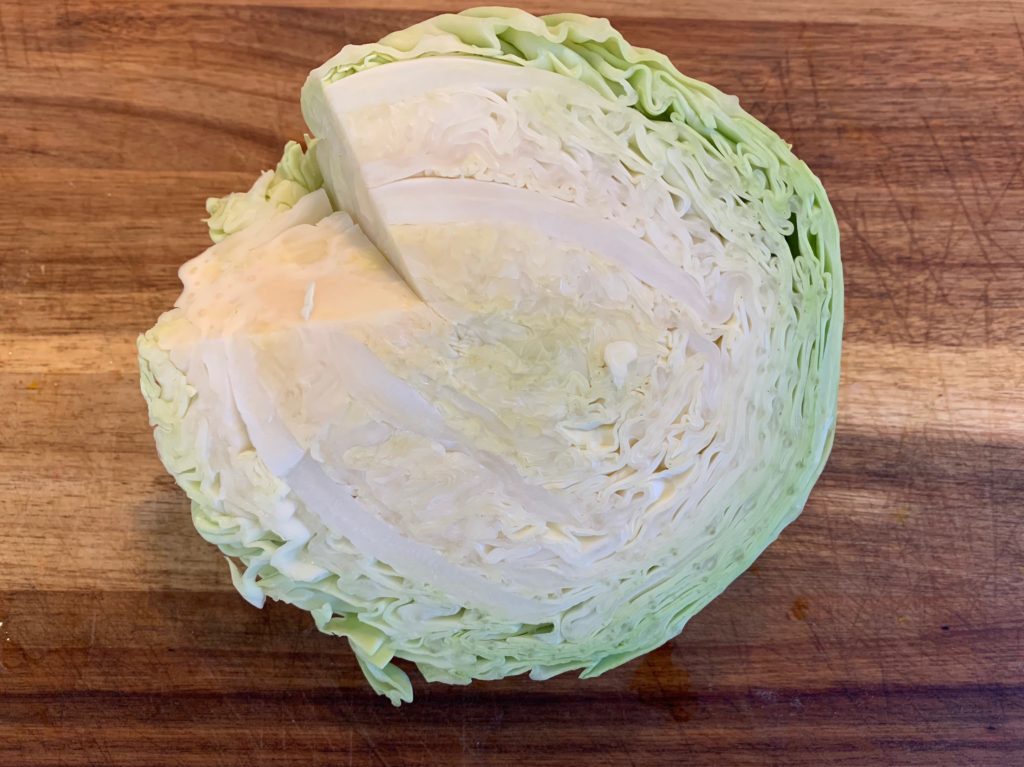
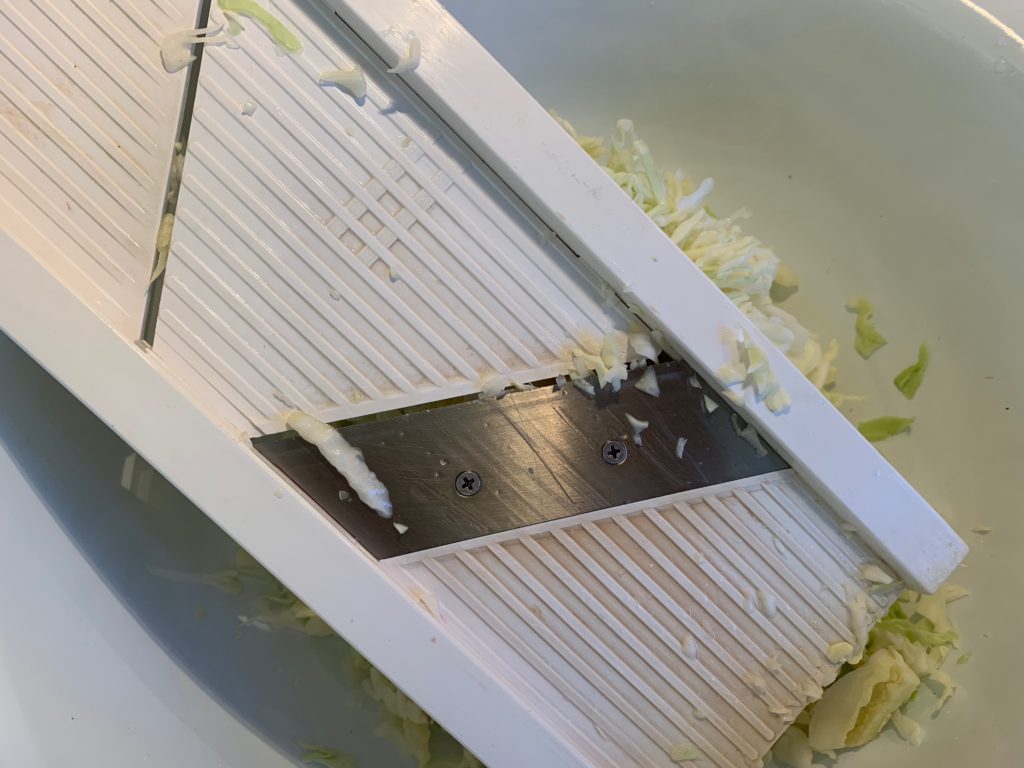
Adding whey to the sauerkraut (optional)
Since I love little hacks, here’s another one: adding whey to the cabbage gives the good bacteria a kickstart. For a medium head of cabbage, you can add about 3-4 tablespoons of whey. I often have whey from making quark. Or you use the liquid that likes to sit on top of your yogurt.
Then, you shred the apples and the cabbage (I personally like the smaller shreds but some people like it more coarsely shredded for extra crunch).
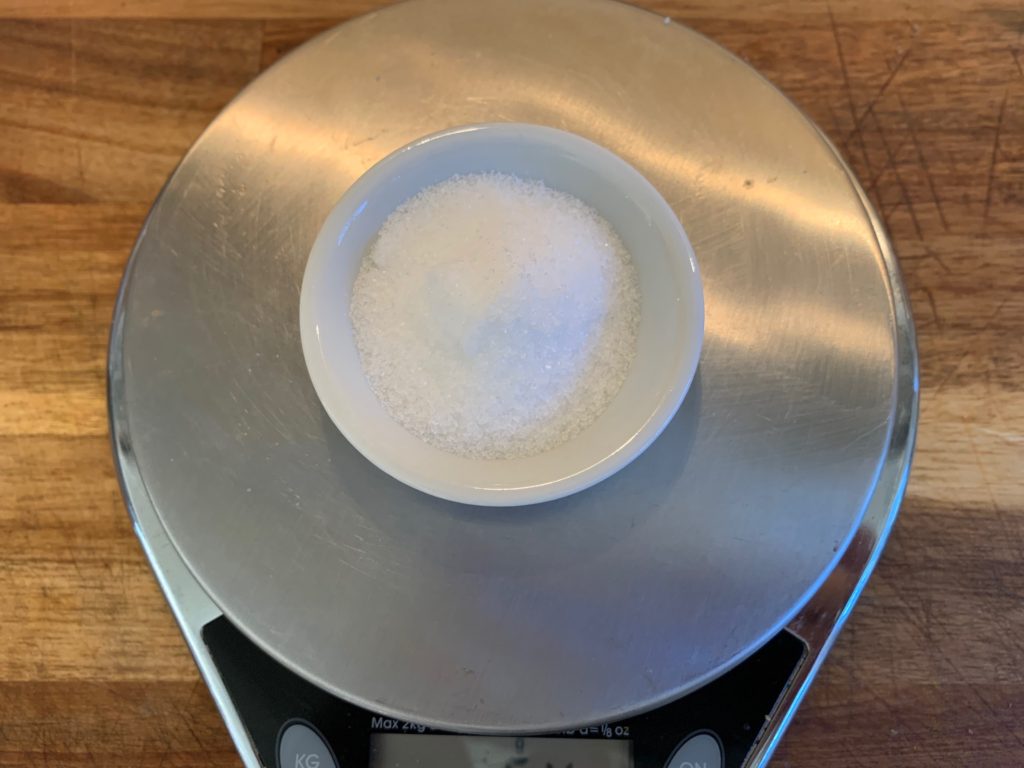
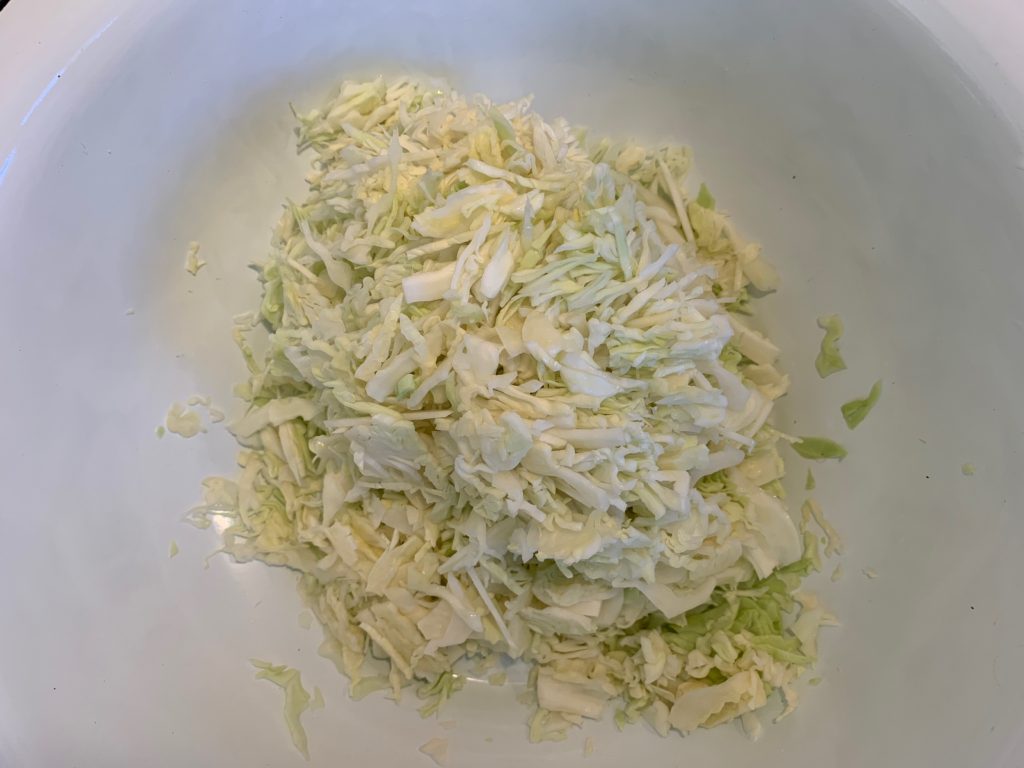
Pressing the cabbage into the mason jars
Next, you’ll put your cabbage in your fermentation jar. I use very simple quart or half-gallon mason jars. Make sure to push the cabbage tightly in there with your tamper. As you’re doing that, you’ll notice the brine rising up. This ensures that your ferment is completely submerged.
Lastly, when all your cabbage is tightly packed in the jar, you cover it with one or two of the outer leaves you have saved. To keep everything submerged, you need a weight to hold it down. I have some rocks that I have sterilized and only use for this purpose. You can also get fermentation weights. Some people even like to have a smaller, water-filled mason jar pressing everything down.
Now, you need to put a lid on. I like using fermentation tops such as this or this one. They allow gases (carbon dioxide) to get out without air getting in.
How to long-ferment sauerkraut
Now you place your jars in a dark place at room temperature for about 3 days. I always write the date on my fermentation jars. After those 3 days, I move my jars to a dark and cool place. This slows down the fermentation process. Underneath our 110-year-old house, there is the dark, cool, somewhat moist crawl space. Or you might have a basement or cellar but even the bottom of your pantry works.
I encourage you to NOT open the lids in the first 3-6 days of fermentation. After that it’s fine to periodically taste your sauerkraut.
When it has the preferred taste and texture, I often move it to the refrigerator. If you do have a nice cool dark place, you can also keep it there.
Another sauerkraut recipe
While it is great to stick with a basic and classic recipe, I often like to mix things up. Therefore, I often make a “ruby kraut”. For that I use a head of red cabbage, one red beet, and a knob of ginger. I shred the cabbage with the mandolin slicer. For the red beet you can use a box grater or the “matchstick” attachment for your mandolin slicer. Most of the time, I cut the ginger with a kitchen knife.
This sauerkraut has a slight earthy-sweet taste that gets a little kick from the ginger.
Long Fermentated Sauerkraut
Ingredients
- 1 head green cabbage
- 1 medium apple optional
- himalayan or sea salt
Instructions
- Remove outer leaves of cabbage and set aside for later. Shred the cabbage using a mandolin slicer or kitchen knife.
- If using, peel and core the apple. Cut into thin strips or grate with a box grater. Add to the cabbage.
- Weigh the cabbage (and apple). Add 2% of that in sea salt. Mix well.
- Let sit at room temperature for about one hour or until the cabbage looks moist and glossy.
- Using a tamper, press the cabbage mixture into mason jars or sauerkraut crock.
- When the container is almost full, place one or two cabbage leaves on top. Place fermentation weights on top to keep everything submerged.
- Place a fermentation lid on. Let the vegetables sit in a dark place at room temperature for 3-6 days without opening the jars. Enjoy or let sit for a total of 30 days for maximized probiotics.
Nutrition
Shop this post:
Enamel bowl: https://amzn.to/336URgL
Digital kitchen scale: https://amzn.to/336lzGh
Mandolin slicer: https://amzn.to/3aXiKM5
Quart size mason jars: https://amzn.to/3tcSKT5
Funnel: https://amzn.to/2Sm7mTr
Wooden tamper: https://amzn.to/33qeLDf
Fermentation airlock tops: https://amzn.to/2Sm7qm9
Fermentation tops: https://amzn.to/3gWgtnT
Fermentation weights: https://amzn.to/3xHEc1e
Have you made sauerkraut? What is your favorite recipe?
Pin For Later:
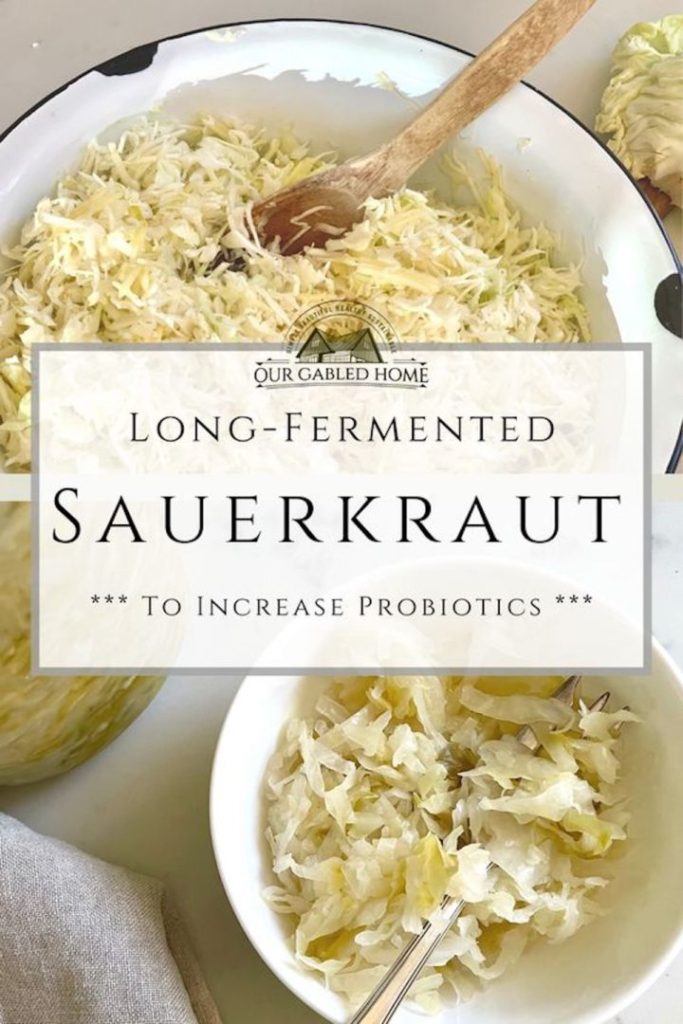


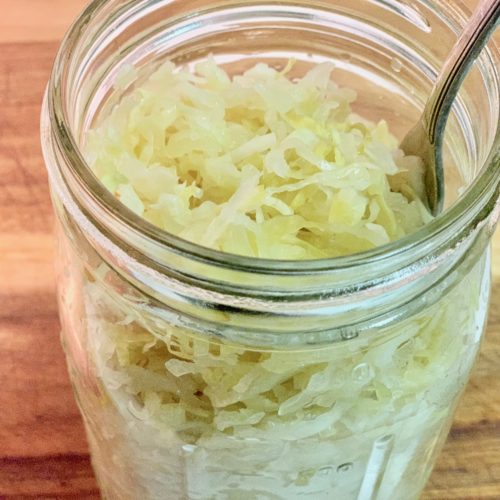
Many thanks for your good descriptions. I’ve been making sauekraut for years, but had not heard of the 2% rule. Going to give it a try next time. We have it often as a side dish with a dollop of real sour cream. Lovely! I’ve experimented with different add in flavors, and we love adding chopped apple and some fennel seeds.
I am so glad to hear this! I, too, love playing with different ingredients ~ Anja
awesome
Thank you!
hello, thank you for this informative post. I have a question about packing the cabbage into the jar. I am using a glass jar and I can see that I have a lot of little air bubbles in there that I can’t seem to get rid of. Maybe I should have spooned just a bit at a time into the jar and tamped it down in between? Will the little trapped air bubbles cause a problem?
Thank you for reading my question!
You definitely want to tamp down the cabbage as much as possible so that there is no air trapped in there. In the olden days in Germany, people used to stomp on the cabbage with their bare feet! Once the fermentation is going, these “air” bubbles can come from the gasses and are normal. Hope this helps ~ Anja
I’ve tried making sauerkraut and few times but was unsuccessful. Your recipe and explanations have inspired me to try again. Thanks for sharing!
Nice! It’s really easy if you follow a few key principles. Happy sauerkrauting ~ Anja
I’ve never heard of the long-fermented process. I’m definitely going to try this!
Yes! The long fermentation dramatically increases the amount of probiotics in your sauerkraut! Happy fermenting ~ Anja
This is a fantastic recipe, Anja! I like to let my sauerkraut ferment for a little bit longer so that it is softer as well. I have never heard of the Ruby Kraut, but that sounds amazing too! Thanks so much for the inspiration! =)
I love sauerkraut. Will be making this weekend. Your recipes are always great and super informative.
Long fermented is the way to go! I feel like the knowledge that this method is exponentially healthier is being lost 🙁 And apple is such a great addition. Thanks for sharing!
Thank you, Diane! I am so glad you enjoyed this!